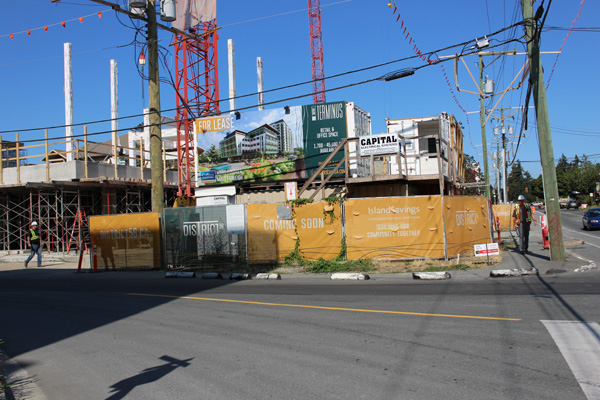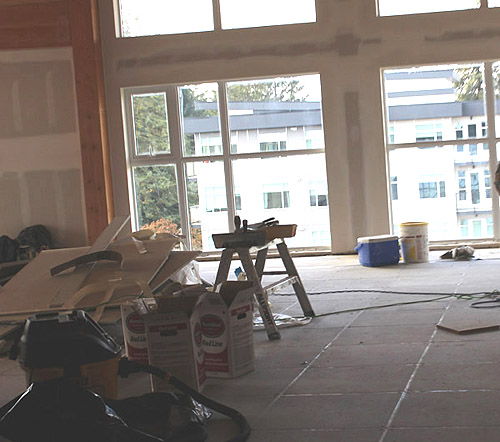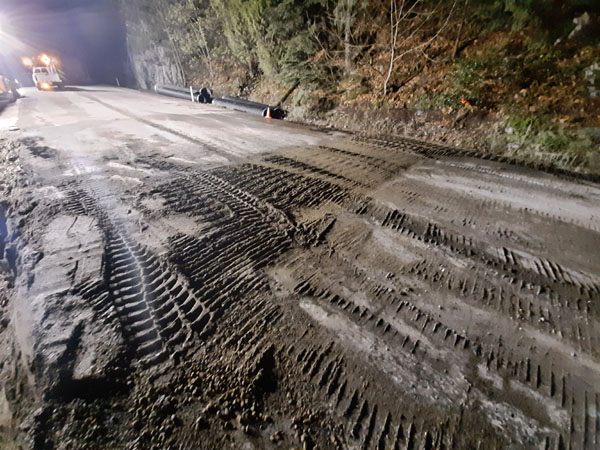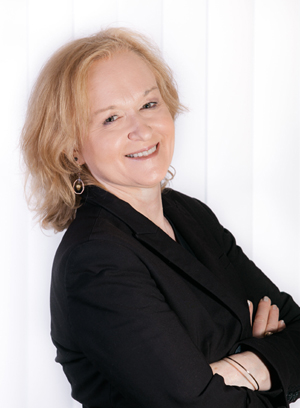
Friday December 3, 2021 | LANGFORD, BC [Updated 12:30 pm Dec 3, 2021 & January 19, 2022]
[BC Government announcement on drug-poisoning prevention services for construction workers January 13, 2022: VICA is awarded a $1 million grant to assist with substance-use education at worksites]
by Mary P Brooke, Editor | Island Social Trends
Ready to be the muscle and might of infrastructure restoration and development on Vancouver Island, the sector of the construction industry that builds institutional, commercial and industrial (ICI) structures is reorganizing and rethinking.
The structured world that interfaces with the natural environment is guided by government policies and regulated by guidelines and standards. But the work is in the hands of developers, builders, designers and planners — the engineers, architects, project managers, suppliers and trades are all part of the mix. Many of those ICI players are members of the Vancouver Island Construction Association (VICA).
Last week we caught up with the vive force of the 450-member organization, Rory Kulmala, CEO, VICA. The members of the new board for 2022 had been announced recently. The governance structure is important, setting the tone for leadership. That’s where the conversation started.
These construction industry leaders coming into focus as big chunks of Vancouver Island infrastructure are opening up to demand for ever-increasing standards around safety and function, alongside the urgent rebuild of things like highways that have recently crumbled in response to the power of Mother Nature herself by recent storms and floods.
And all of this in the crucible of the construction industry having performed as an essential service throughout the COVID-19 pandemic, which has been almost two years now. It’s been tough all the way around.
COVID impacts:
The biggest challenge has been labour. Before COVID there were record levels of construction in the province and in Canada. But the challenge has always been keeping the labour supply healthy and available to serve the construction needs, says Kulmala.
There have been record levels of construction in the past decade; the industry has been booming. But in the past period of nearly two years there have been challenges around labour availability and supply chains due to COVID social, health and economic impacts. But the work isn’t going away.
“COVID stepped in, and for our industry it was a bit of a speed bump,” Kulmala told Island Social Trends. “It slowed us down but it didn’t stop us.”
“Construction very early on in the pandemic was deemed an essential service. It allowed our sector to continue to work. We adapted and we created our processes and work protocols so we could allow our workers to work safely. Then we faced the recovery phase, and certainly vaccinations helped. But we’re really struggling with the social recovery. It’s not just construction,” says Kulmala.
“All the other sectors demanding labour and recruiting from the same pool as we would otherwise be recruiting from. That makes it a bit of a challenge, so it really stresses our industry,” the CEO outlined.
Supply chains:
Interruptions to various supply chains have been another big problem, in sudden unexpected ways and in a way that grinds on longer than producers in society have ever experienced before. The BC Economic Forecast for 2022 is relying on a return-phase of a couple of years, describing the economy as resilient. Though that’s a best-guess at this point, as everything keeps changing in response to ongoing COVID impacts.
For the ICI construction sector, COVID has probably been the single biggest impact to supply chains both from having a capacity to produce materials but also the distribution channels have been extremely stresses. “That’s been impacting schedules and design objectives (some materials just aren’t available in a timely fashion so they’re looking to pivot to something else),” said Kulmala.
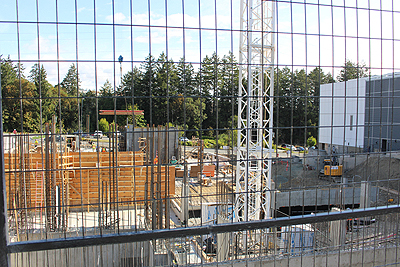
The availability of electronic parts was a concern last year, as a lot of those components come out of Asia (when production there got shut down due to COVID, then distribution gets hampered). Things like an electronic part for an elevator that’s not available can make a big difference to how a building is completed and what functions are available in a building.
And then there’s global competition. “As the recovery happens, all the other parts of the world are trying to do the same as we’re doing,” he explains, noting there are the same demands on resources and materials from all parts of the developed and developing world. That results in supply that is “sorely lacking”, and demand is extremely high.
All of that creates a big imbalance in the economic resiliency regionally, provincially, nationally, or in North America, says VICA’s CEO.
Waiting for supplies to arrive is also a cost, as it slows down production, or finding a substitute product takes time and unplanned cost.

- Lumber. We saw a spike at the turn of the year, prices effectively tripled for commodity-based lumber. Due to mills shut down, the supply became extremely short; that has now recovered. The biggest stresses come from anything that is imported.
- Large-volume steel. We have capacity in North America, but a lot of that does come from overseas. So anything that’s relying on our shipping and that has to move into our country from another country has been a challenge. Borders were closed. We saw the impact of Suez Canal, where that effectively blocked our entire distribution economy. We can look at all the ports on the western seaboard to see that we don’t have the capacity to unload ships fast enough.
- Raw materials, concrete and pavement. A lot of that is domestically sourced. The costs are going up but it doesn’t mean it’s not available. Anything that’s imported you have to be wary that it’s going to take a long time. And anything produced outside of country, expect it to take longer and be more expensive.
Projects are taking much longer to build now; standards are high and labour is spread thin. Kulmala described it as “the labour supply is stressed”.
Big directions:
A challenge in recovery from the pandemic, and now the recent storm-impacts, is to be persistent with public investment, and be consistent in continuing with projects.
Putting projects on hold because of cost is risky, because “we’ll never be able to build cheaper than we can today”, he says. “This catastrophe we’ve experienced in BC with failing infrastructure is going to put an additional stress on the supply of materials.”
COVID has hit the population of this planet like a scourge. Human hubris has left societies, economies, countries and communities reeling. Individuals and families bear the brunt, with disparate economic impacts and mental health repercussions from all the physical, emotional, fiscal and functional disruptions. Kulmala gets all this. This insight helps shape what the VICA board may do in the year ahead, and beyond.
Board directions:
The Vancouver Island Construction Association is excited about their new board composition for 2021-2022. The board’s refresh includes two women within the industry, and also two new members of sectors not previously represented (a supplier and a civil contractor). There’s an upbeat energy, a sense of enthusiasm and eagerness for the industry to be doing well, and VICA’s CEO Rory Kulmala expresses that well.
This year’s VICA board election saw record highs for both nominees and number of votes cast, apparently from a level of interest to be “part of a greater construction community and we represent that well”, says Kulmala when asked why the increased level of board participation this year.
“People who serve on boards are ultimately looking to contribute to a sector in the hopes that it makes their sector better, or they’re able to grow or enhance it,” he says.
Board mix:
For 2021-2022, Chris Lyons of Omicron Construction Ltd has assumed the role of Chair of the Board from James Clapp of Wilson M Beck Insurance Services. Lyons says he’s keen to take on the opportunity to represent one of the largest industries on the Island.
Vice-Chair is Kate Ulmer of Herold Engineering Ltd, Treasurer is Stuart Cuthbert of Mazzei Electric, and Secretary is Barclay Ellis of Trades Labour Corporation Victoria.
The VICA board of directors includes now incumbents Paul Gray of Farmer Construction Ltd, and Barclay Ellis of Trades Labour Corporation Victoria were re-elected to their positions. Women elected new as board members are Allison Greaves from Durwest Construction Management and Jac-Lyn Mickelson from MGM Mechanical.
Josh Fayerman of Milestone Equipment Contracting Inc is a civil contractor out of Parksville and Samer Akouri with AccessSMT Holdings Ltd. They were each appointed for a one-year term, after the AGM, to make sure the board had a full complement of sector representation.
Outgoing Past Chair Roger Yager, Knappett Projects Inc., was recognized for 10 years of service on the VICA Board.
CEO, board and membership:
Kulmala describes his CEO role a being “the hands of the board”. Coming up on five years now, he keeps an eye on the industry, develops and guides programs that benefit the membership. The board is a sounding board for ideas that he might come up with based on what’s going on in the industry. He works the details of the annual budget before it’s put in front of the board.

The 15-member board is about governance, to guide overall strategy and behaviour of “what we do and how we do it”, to run the non-profit well. They’re collaborative.
The board has a goal of diversity, and they want to grow the presence of women in construction, said Kulmala in an interview with Island Social Trends last week.
VICA has about 450 members representing the commercial, industrial and institutional construction industry on Vancouver Island and the Sunshine Coast. About three-quarters of the membership is in the south Vancouver Island area, with others up-island and in related communities.
General contractors, trades, insurance and bonding coverage, and a professional engineer are on the board; the recent appointments brought in a supplier and an additional rep to cover the civil construction segment. “That rounds out the true representation of all segments of construction on Vancouver Island,” says Kulmala.
VICA creates and offers education, and works on the advocacy and networking fronts. There’s an annual strategic planning session to keep these things fresh and on track.
Five key challenges:
VICA has these five things, at least, to grapple with: safe working environment, construction worker well-being, supply chain challenges, economic recovery, and planning for resilience.
Safe working environment:
When the pandemic hit in March 2020 there were immediate changes to be made. Workers on job sites had to be physically distanced, and arrive and leave on a pre-determined schedule (organizing around drywall, plumbing and electrical). Processes were adapted to lineup with all the health and safety protocols as outlined by the Provincial Health Officer. This took a lot of administrative planning and caused construction slow-downs. An upgrade from hand-sanitizing to full hand-washing stations was done in many cases.
Teams were kept very small, limiting to sometimes four or five people in the same space. Passage routes were set up through a project. The occupancy level of elevator lifts was reduced, sometimes from 15 down to two workers; this really slowed down production.
COVID vaccination really “eased things up” for construction workers on site. More owners are demanding that construction sites have mandatory vaccination against the relentless virus that has been with us for now almost two years.
Construction workers and substance use:
VICA sees that the age profile of most of their workers lines up in parallel with the demographic of many of the people (mostly males in their 20s to 50s) who have been suffering from addiction and dying of toxic substance use. Kulmala is obviously not happy to report that about 25 percent of opioid-related deaths were among people working on construction. “It’s a social problem that is affecting our workers,” he said.

Of the toxic-drug related deaths, 81 percent were male, in the 24 to 59-year-old age groups. The demographic lineup with the construction industry is that “they work hard, they play hard”. The idea of “male bravado” is prevalent, in that seeking help is usually not readily done. “They’re reluctant to talk about it. Problems fester and this impacts workers.”
“The job has physical demands, they get injured, and there is pain management (with medication),” says Kulmala. COVID-management stresses would not have helped.
The cross-over of age demographic could even be seen in the notably lower number of COVID cases on Vancouver Island among people ages 40 to 49 (compared to the BC average), as seen in BC Centre for Disease Control stats since early on in the pandemic. Island Health has never really come out and offered a reason for that anomaly, which could likely only have been four things: people ages 40 to 49 were healthier and more resistant to COVID; proportionately more people in that age group were working outdoors (less impacted by airborne transmission of COVID); if there were naturally fewer islanders in the 40 to 49-year-old cohort; or this was the age group highly impacted by drug overdose. Lately, however, the BC average for COVID cases among the 40s cohort seems to have caught up with the Vancouver Island profile.
Kulmala quotes public health statistics that 71 percent of fatalities due to substance use happen in private residences, among “people of means”. He states: “Our workers are part of this.”
“We want our workers to go home safe at the end of the day, and return to work the next day,” says the VICA CEO.
Supply chains:
Supply chains were impacted fairly quickly by pandemic scenarios, with labour-impacted production and shipping challenges contributing to the delay of receiving some ordered pieces for buildings, including steel products and electronic parts. That was a global supply chain reality, with local impacts. “Distribution channels were extensively stressed,” said the VICA CEO. “Supply became extremely short and demand is very high.”

Some projects are taking longer to build as a result of the supply chain delays. Even the local SD62 school district said their two new schools in Westhills were waiting for steel beams from an international source, though they say the schools under the oversight of Farmer Construction will still open on time (in September 2022).
All around the globe there has been demand for the same pool of resources and materials. Border closures added to the problem, as well as shipping backlogs like in the Suez Canal (where a large cargo ship called the Ever Given was refloated after a major six-day salvage operation in August 2021) which “blocked an entire distribution economy”, says Kulmala.
Labour shortages due to COVID protocols or illness of dock and distribution workers meant ships could not be unloaded fast enough. All of that led in some cases to changes in construction schedules even here on Vancouver Island, and even some changes in building design based on what was available.
There was a run on plywood as home renovations became the hobby of choice for many people forced to spend a lot of time at home. That challenged supply levels for mainstream commercial projects.
Lumber costs went up significantly across the board. That has ultimately contributed to the higher cost of housing everywhere on the island and across BC, but also impacted the island’s commercial and industrial construction sector that VICA guides.
Concrete and pavement are domestically sourced so there’s less of a supply problem there, but the demand for workers is constant.
Economic recovery:
As the economy has been recovering there is a lot of demand for qualified workers, as some are evidently making their way into other sectors like tourism.
“We will never build cheaper than we can today,” concludes Kulmala, based on all the cost, labour and supply pressures. Nonetheless, the work carries on. He notes the recent challenges of community and highway infrastructure as just one example of where the industry has a huge role to play in the months and years ahead.
Anything that has been bid out in the past year has kept COVID-impacted escalating costs and the need for flexible timelines in mind, the VICA CEO says.
He sees the role of VICA as promoting positive relationships with all stakeholders.
Planning for resilience:
Recent natural disasters (like the flooding from heavy rains earlier this month) will put additional stresses on the demand for concrete and steel. Work got underway right away on repairing the Highway 1 Malahat for example, with contractors working for the Ministry of Transportation and Infrastructure getting that main transportation artery back open in a matter of days.
The magnitude of recent events which “caught us off guard”, highlights the need to question and review things from a design point of view. The safety factor for loads is already built for seismic, says Kulmala, but perhaps now it needs to be even more strident, and looking to a broader range of things around the infrastructure such as water distribution systems and the impacts of surrounding forestation.
He notes how last month all highway routes were lost for getting to the Vancouver lower mainland (and the port) from the Fraser Valley, as well as how loss of use of the Malahat impacted workers, businesses, families and the economy for several days here on Vancouver Island.
“We need resilient backup plans.” The built environment either keeps people safe, or it doesn’t. “Politicians need to understand,” says VICA’s CEO, noting that attention to this has been slipping for the past 20 years in infrastructure development.
Infrastructure needs provincial and federal attention:
Who’s responsible for what part of infrastructure development needs review. That was highlighted by Premier John Horgan last Friday evening, November 26, in a press conference with Prime Minister Justin Trudeau in Victoria, in the context of how municipalities had been left over the years to try and design and fund major infrastructure projects on their own, without direct provincial or federal input or funding (or, with direction and standards, but no funds to back it up).

Leaving decisions about infrastructure within municipalities up to the municipalities themselves was a political stance of previous governments, which Horgan said clearly needs to change.
“We are here to accelerate recovery,” says VICA’s CEO. Road recovery is one example of where the commercial industrial construction industry jumps right in. “First responders take the initial call, but we rebuild it,” says Kulmala.
A few times in the past couple of weeks during press conferences about the government’s emergency response to massive flooding, Transportation and Infrastructure Minister Rob Fleming has remarked that the construction industry is essentially ‘raring to go’, to start rebuilding the key infrastructure in BC.

Malahat alternate route:
In this context, VICA is a proponent of having an alternative route to the Malahat, for those relatively frequent times that that section of Highway 1 is blocked off (oftentimes by motor vehicle incidents, but also landslides and now floods).
Materials were barged by a temporary ferry system (Duke Point/Nanaimo to Swartz Bay/Victoria) during the most recent Malahat closure, but that sailing took 3.5 hours and ship capacity was limited. That was a welcome solution, but a ‘bandaid’ one.
An alternate route to the Malahat (probably rail) would be for the goals of increased traffic volume, better access, and of course designed around seismic impacts and flooding. Given the regional and provincial importance of Highway 1 — part of the Trans Canada network — there room there for provincial and federal design and funding contributions.
Local politics:
It’s hardly a new topic to discuss the complexities of how 13 municipalities handle planning and development in the Greater Victoria area. Each has their own philosophies, policies, guidelines and processes.
Hands down, Langford gets it right, says Kulmala. “They’re the poster child for what municipalities are trying to do.” The City of Langford’s permitting process is fast, and zoning has adapted to the needs of a fast-growing population. They take a problem-solving approach and are eager for economic growth.
“Langford is aggressive with infrastructure and they step up to meet demand,” he says, including traffic needs. “It’s a pragmatic approach,” he describes in summary. That’s even while there’s a lot of public resistance from sectors of the residential community that feel the city they’ve chosen to live in (either long ago or recently) is changing too much, or too fast, or without adequate attention to natural space within the built-up structures. But for the most part, Langford has the construction industry’s back.
Kulmala is quite open about saying that development views in one area of Greater Victoria are not always shared in other municipal areas in the region (noting the City of Victoria in that regard). In many ways Victoria has led on social awareness about infrastructure but the translation of that into the built environment has not always been fluid or timely.
Kulmala hopes that VICA’s leadership can see the entire region embrace new standards toward getting things done more quickly, but done well.
All 13 municipalities and three electoral areas are represented on the 24-member Capital Regional District (CRD) board.
The next municipal election on October 15, 2022 is now less than a year away. The management of infrastructure has likely already shot way to the top of campaign platforms that are in the works.
===== RELATED:
Emergency update Dec 1: Financial relief, weather analysis, supply chain (December 1, 2021)
Saanich suddenly parts ways with CAO (November 30, 2021)
Trudeau meets with Premier Horgan after visiting flood-damaged agricultural area (November 26, 2021)
Reunion at Belmont construction is underway (November 19, 2021)
Langford announces bold low-carbon concrete policy (November 18, 2021)
Terminus building in Langford sets high standard for office space & services (November 5, 2021)
New Cowichan Hospital construction aims for 2026 completion (April 4, 2021)
COVID exposure at Customs House construction site March 15 to 17 (March 27, 2021)
===== ABOUT THE WRITER:
Mary P Brooke is the editor Island Social Trends, published by Brookeline Publishing House Inc. She has been covering community development news on the west shore since 2008.
The publishing office is centrally located in Langford, covering the full Greater Victoria area and south Vancouver Island region.



